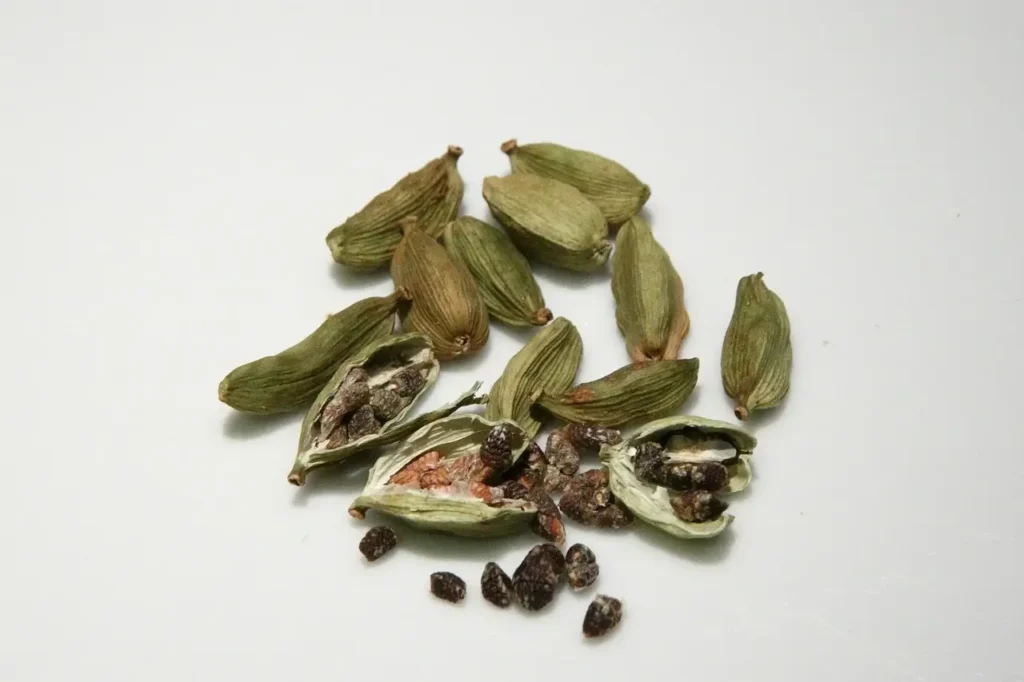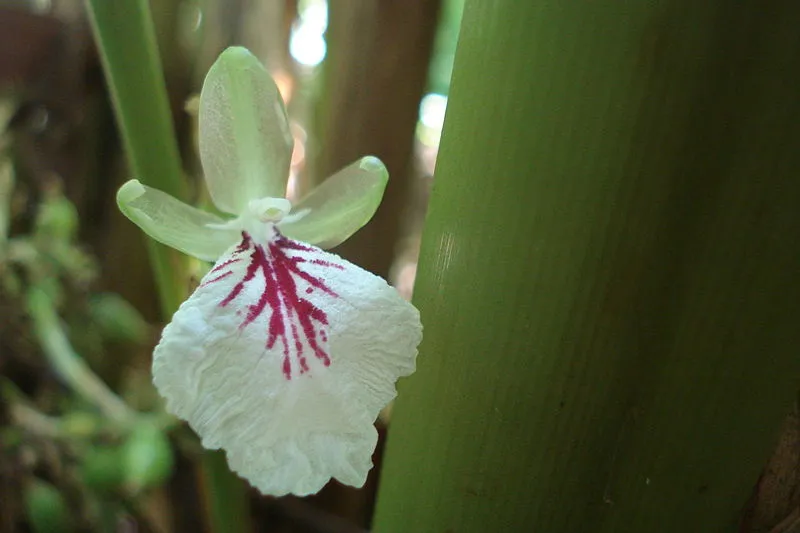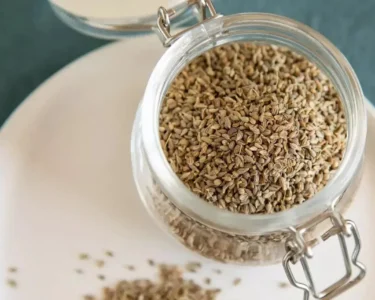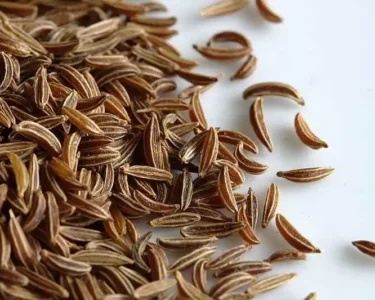What is Cardamom?
Cardamom, sometime as cardamum or cardamon, is a herb which is used as a spice in food. It is widely said that it has an aroma of the field and a flavor of the grove. It comes form the seeds of plants that are of Elettaria and Amomum in the ginger family. Due its flavor and use, it is also known as “Queen of Spices”.
What do Cardamom seeds look like?


These seeds are small black seeds that are located enclosed in the small pale brown or greenish coloured pod. These seeds are the portion that forms the spice and they are characterized by their small size and aromatic taste.
Here are some key points about these seeds:
- Appearance: They are small, black and somewhat oval seeds.
- Flavor and Aroma: The seeds, in fact, have a very rich and citrusy taste and are also very fragrant. They have oil-bearing glands that are responsible for making them have the special fragrance as well as taste.
- Storage: It is recommended to store them in a cool and dry place and more so, away from direct sunlight.
Tip: Store the pods as a whole and ground them just before using as freshly grounded seeds are far tastier and fragrant.
Cardamom Types:
There are many types and derivatives of Cardamum. There are two main types:


Green Cardamom: (Elettaria cardamomum)
These pods are green in color. They contain small black seeds which can be ground or whole to be used in the recipes.
This is often added to desserts and sweets like baklava and kheer.
Used in meat and vegetable curries, hot dishes based on rice and as a spicy addition to tea or coffee.
Black Cardamom: (Amomum subulatum)
It has smoky flavor and can help to enhance the flavors of foods which have heavier elements of spice such as dishes from Indian cuisine.
Each type possesses this reputation for being aromatic and each is thought to have a positive side with digestion as well. This is an all-round spice that enhances the taste and flavor of many meals and can be broken down into several categories of spices.
Cardamom Seeds vs Pods
Cardamum seeds and pods refer to different parts of the plant and are used in distinct ways in cooking and culinary applications:


Cardamom Pods | Cardamom Seeds | |
Appearance | Elongated capsules | Small, Oval Shaped |
Color | Green | Black |
Aroma | Fresh, Herbal and Citrusy Aroma | Strong Spicy Aroma |
Flavor | Mild, sweet and floral flavor | Slightly sweet and citrusy flavor |
Usage | As a whole pod or slightly crushed form | Grounded into powder |
Dishes | Curries, Rice dishes and some desserts | Cookies, cakes and puddings |
Beverages | Chai Tea | Coffee and Tea |
To sum up, pods are the green husks of spices that encompass the inner seeds with the fragrant smell. Both parts are integral to the spice’s use in various cuisines, but their application in cooking differs: As for the pods, they are normally used whole, or slightly crushed; seeds, on the other hand, may be used ground or whole depending on the kind of recipe one is preparing.
Cardamom Seeds Health Benefits
Since cardamum is rich in nutrients, it provides specific nutritional benefits, and there are active compounds that have been known to have the positive effects on the body.
The following are the few possible health benefits:
Digestive Health:
These aromatic seeds contain oils and are traditionally used as remedies for digestion problems. They assist with conditions such as bloating, gas, indigestion, and acidity. These oils contain ingredients such as cineole that encourages the formation of digestive enzymes.
Anti-inflammatory Properties:
Antioxidants in cardamum such as flavonoids and phenolic compounds exercises an anti- inflammatory impacts on the body. These antioxidants contribute to a decreased occurrence of diseases related to inflammation.
Improves Oral Health:
The antibacterial property of cardamum also assists in fighting against the bacterias that lead to oral halitosis and tooth decay. And the people love to chew seeds for breath freshening.
Heart Health:
A number of researches has pointed towards favorable effects of cardamum on the cardiac health of individuals. It is useful at lowering blood pressure because of diuretic characteristics it possesses and it seems to decrease the likelihood of heart ailments by improving cholesterol levels.
Antioxidant Activity:
It contains antioxidant compounds such as catechins, terpenoids, and flavonoids that shield the body from free radicals that may cause havoc on the body systems. These compounds shield the cells and cause a decrease in oxidative stress.
Anti-cancer Potential:
Some studies suggest that cardamum has some anti-cancer characteristics. In accordance with other investigations, its extract possess anticancer properties that can prevent the growth of cancer cells and cause their death in some types of cancer. However, further research has to be performed to evaluate the role of this antioxidant in cancer prevention and some other illnesses.
Weight Management:
Cardamum works efficiently for weight reduction by increasing the metabolic rate and enhancing digestive system. Its thermogenic ability helps boost the body’s ability to burn fat.
On balance, cardamom promises similar unique application in cooking besides providing a rich scent and taste. Several factors determine the effects of these seeds and they should be included as a seasoning in moderation in a diet and exercise regimen for healthy lifestyle.
Cardamom Seeds Uses
Cardamom is popular spice which is added to cooked preparations, baked food products, and different drinks by people of different culture in many different ways.


Here are some common uses of cardamom:
Culinary Uses:
- Spice Blends: Some of the popular blends that include cardamum as one of the components include Garam masala which originates from the Indian sub-continent and Baharat a common spice blend from the Middle Eastern countries.
- Curries and Stews: By enhancing the deeper notes as well as the fragrance of rich flavours, it works well in curries, stews, and rice pilaf.
- Desserts: It has ability to complement desserts. That’s why, it is added to cakes, cookies, pastries, and even to rice pudding.
- Beverages: This condiment is added in preparing beverages such as Chai tea, coffee, and many sorts of herbal tea.
Baking:
- Cardamum seeds, whole or ground, are used while baking breads, rolls, muffins, and other bakery products and gives them a unique taste.
Drinks:
- Whole green pods or seeds are occasionally used to prepare foods such as coffee and tea to make warm, aromatic beverages.
Sweets and Confections:
- Cardamum is used in preparing the local sweets and confections such as baklavas, kheers which is an Indian rice pudding. In Sweden and Norway, it is used in pastries.
Medicinal and Herbal Remedies:
- Culturally, cardamum has been used as traditional medicine in treating sustenance, aromatic salt and stimulate intestinal movement, eliminate bad breath, and to help flue and cold.
Flavoring Agent:
- It is used as a natural enhancer in the ice-cream, syrup, sauces, and even in the beverages like in the cocktail confectionery.
Home Remedies:
- In home treatment, crush the cardamum seeds or pods and use it in treatment of digestive problems and cleansing of the oral cavity for instances, treatment of bad breath.
Aromatic Uses:
- Looking at the other uses of this spice, these may be added to potpourri or used for aromatherapy.
Not only it is used for sweet dishes but also in dishes that are savory. This and the fact that it has a lovely aroma, makes it a very popular spice all over the world. This gives it this special unique taste that can be highly complementary to a number of dishes.
Cardamom Seeds Side Effects
Although the seeds of the cardamoum plant and its derivatives can be ingested when present in small quantities in foods, but in large doses or individuals with sensitivity to the plant may have adverse reactions. They have adverse side effects on both males and females.
Following are the few side effect which should be kept in mind:
1. Allergic Reactions:
Allergic reactions can range from mild redness, itching, and swelling, and may progress to breathing issues or anaphylactic shock. If you experience any reaction that you believe to be due to seed consumption, do not take the seeds any further and consult a doctor.
2. Gastrointestinal Issues:
In certain people, excessive consumption of cardamum seeds, whole or supplements also leads to certain side effects like stomach ache, frequent loose motions, nausea etc. This is especially possible if the person being served has some delicate stomach or any conditions that affect their digesting system.
3. Interaction with Medications:
Interactive effects exist between these seeds and some medications since it may contain compounds that may reverse some of the active components of these drugs. Before using large amount of cardamum seeds, please inform your doctors especially those of you who are taking medication for liver problems, blood clotting and cardiovascular problems.
4.Pregnancy and Breastfeeding:
Uncooked seeds also appear to be safe in food-level dosages. However, caution must be taken in the intake of supplements and large doses have not been confirmed to be safe for pregnant and breastfeeding mothers.
5. Blood Pressure and Heart Rate:
There is evidence that, similarly to other stimulants, cardamum seeds reduce blood pressure and a decrease in pulse rate. People with hypertension or cardiovascular disease should be particularly careful with cardamum seeds and should report any of these symptoms to their healthcare provider.
However, it is essential to mention that within a standard diet, most people will not undergo adverse effects from consuming these seeds.
How to Plant and Grow Cardamom From Seed (Cardamum Seeding):


If you’re interested in knowing how to grow cardamum from seeds, there are few essential steps you have to follow:
- Seed Selection:
Obtain fresh seeds from a reputable source. Make sure your seeds are clean and free from any sort of mold or damage.
- Seed Preparation:
Cardamum pod outer shell are harder which may affect the germination rate. One of the ways to boost the germination chances to put seeds in warm water for 24 hours before sowing. This assists in making the seed coat less hard and hence allows germination to begin.
- Planting:
Sow the seeds at a depth of about 0. 625 inch in seed pots or seed trays in potting mix. The soil should be moist at all times but avoid having stagnant water on the soil after watering the plants.
- Germination:
C seeds usually take between 2-4 weeks to sprout under suitable conditions (warm and humid). Allow the pots or growing trays to be in an area that can receive moderate light from the sun but not full sun exposure.
- Transplanting:
When seedlings have two to four true leaves, you can transfer the young plants from the starting pots to larger pots if you want to grow them indoors. And if the weather is right, you can transfer them directly into the garden.
- Care and Maintenance:
Make sure to provide young plant care it needs. Water regularly for healthy plant growth but not do not over-water.
- Harvesting:
This crop requires several years before it is ready to yield seeds or seed pods. Usually, they start to flower in the second or third year. The pods mature successively and are collected when they are light green with yellowish-brown shades. Dry the harvested seeds for further use.
Where to buy cardamom seeds?
Ilachi seeds are commonly used in many recipes all over the world as a spice or just to add flavor. Because of this reason, they can be bought at different places such as in local markets, in specialized shops selling spices and herbs and many online shops.
The following are some of the places where you can purchase these seeds:
Grocery Stores: The grocery stores with a variety of spices and international grocery products are likely to stock seed pods of cardamum. Look in the aisle where spices are stocked or the aisle that offers products that are from other countries or different cultures.
Specialty Spice Shops: You can buy a superior product in the specialty spice stores or shops that deal with Indian foods. These shops could in fact have a number of cardamum types and grades more than a particular store.
Online Retailers: Specialty spice shops and websites and other markets including Amazon, and Etsy have a variety of seeds for sale. You can easily compare prices of the different stores or sellers or read customer reviews and select between various brands and types of cardamom seeds.
Local Markets and Farmers’ Markets: You could try visiting local food markets such as stores that sell spices and find good quality seeds.
Bulk Food Stores: Sometimes in the bulk food stores, which are also found in natural food stores, seeds are available in bulk, thus users can buy them based on their preferred quantity.
Though, it is important to take some factors into consideration when purchasing seeds, like, the quality of the seeds and freshness of the seeds should not be overlooked. It is advisable to store these seed as a whole for longer shelf life and ground them into powder as they are far tastier when used immediately.
Conclusion:
Gardening Cardamom seeds is quite possible, though not easy and one needs determination and knowledge on how to cultivate the plant. Although it would not work very well for everyone because of the conditions that are needed to grow the plants, for those who enjoy having cardamum, cocoa, cinnamon or similar plants, it can be a great experience. Happy Gardening!
Visit our home page for more exicting articles: www.gardeningoveralls.com
FAQs:
How many cardamom seeds in a pod?
The number of cardamum seeds depend on the size and variety of the pod. In most cases, a mature pod has an approximate of 10-20 small and black seeds on average. But, this normal may change depending upon the type or size pod or from the level of pod maturity.
Green pods contain more seeds compared to black pods, and the size of the pod determines the number of seeds that are found in it. While preparing recipes, the pods are usually recommended to be crushed or split to expose the seeds and release their flavor.





